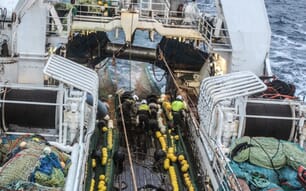The conservation group made the claim as it published its end of year assessment of the state of Scotland’s main whitefish stocks..
The conservation group revealed its assessment as Europe prepares for a year that will see the biggest shake-up of the fishing industry since the Common Fisheries Policy (CFP) agreement was first established in 1983.
Based on the latest scientific information, existing management plans and recent announcements on quotas WWF Scotland made the following end of year assessment of four of Scotland’s most important whitefish species:
COD
(Value: £16million p.a. Volume landed: 7,645 tonnes)
- Thanks to quotas being set in line with scientific advice, Europe’s Cod Recovery Plan, Scotland’s Conservation Credit Scheme and the support of the fishing industry North Sea cod is showing early signs of recovery.
- To the West of Scotland however, the situation is not so positive and WWF believes that conservation efforts must continue if the stocks here are to recover.
HADDOCK
(Value: £33million p.a. Volume landed: 29,488 tonnes)
- In the North Sea haddock are managed under a long term management plan and currently this stock is considered to being exploited sustainably.
- However, on the West of Scotland, where a management plan is still only in the developmental phase, haddock stocks are being fished beyond safe limits.
- WWF believes measures to protect West of Scotland haddock are urgently needed.
WHITING
(Value: £9million p.a. Volume landed: 9,226 tonnes)
- Inadequate biological data exists, so no clear picture or scientific recommendations exist about the state of these stocks.
- Until more data is collected WWF believes whiting should be exploited at as low a level as possible.
- Unfortunately, EU Fisheries Ministers recently agreed quotas for North Sea whiting 74 per cent higher than scientific advice recommends.
MONKFISH
(Value: £28million p.a. Volume landed: 10,086 tonnes)
- The fourth most important species landed in Scotland. This is a relatively new target species, and scientific knowledge needs improving. However, preliminary assessments suggest the stocks are healthy.
- The quota set for 2010 is the same as the quota for 2009 and continued work is being carried out to improve scientific knowledge of these stocks. Until this data is collected WWF believes exploitation should be precautionary.
Commenting, WWF Scotland’s Marine Policy Officer, Louize Hill, said: “Scotland accounts for over two-thirds of UK quotas, and last year Scottish fisheries landed £400 million worth of fish into Scottish ports. The main species caught in the mixed whitefish fishery in Scottish waters are cod, haddock, whiting and monkfish. As it stands fish stocks in the North Sea are generally in better shape than in the West of Scotland.
“While the measures imposed on Scotland’s fishing industry in recent years have been tough, it looks like all this effort is starting to pay off. Thanks to long term management plans and initiatives like the Conservation Credits Scheme North Sea cod and haddock stocks look to be heading in the right direction at long last. Most West of Scotland stocks still remain at risk, but it is now clear that sensible quotas alongside other conservation measures could help turn this situation around.
“WWF Scotland has been working closely with key industry players in the whitefish mixed fisheries over the past years, working towards improved sustainability of these fisheries, including active participation in the Conservation Credits Scheme.
“Scotland’s fishing industry has a long and profitable future ahead of it, but only if long-term conservation measures are continued and the European Common Fisheries Policy (CFP) is reformed this year along more sustainable lines.
“The existing Common Fisheries Policy has failed fishing communities, and failed to protect fish stocks. We must do better and so 2010 will be a critical year with the CFP reform process really starting to get underway. There are many good examples from Scotland to be shared with other European countries. We hope this reform will lead to long term management plans for all fisheries and increased regionalisation of management.”
Responding to WWF Scotland’s year-end assessment of Scotland's main whitefish stocks (embargoed until 00.01 Sunday 3 Jan. 2010), which included supportive comments on the leading role that Scotland is taking in ensuring a sustainable future and the need for sensible reform of the Common Fisheries Policy, Bertie Armstrong, Scottish Fishermen’s Federation chief executive, said: ”The only real way to make lasting progress is to involve the industry in the development of fisheries management. That has begun in Scotland, but the challenges now visible for 2010 mean that ever-closer cooperation between all stakeholders will be essential.
“WWF's supportive statements are very welcome - a telling change from the dialogue of the recent past and a hopeful note as we face difficult times in the immediate future."
Scottish fishermen in co-operation with Government and scientists have been spearheading a number of conservation initiatives to help ensure a sustainable and profitable future for the industry. These include:
- All Scottish vessels affected by days at sea are in the Scottish Government’s conservation credits scheme, which offers fishermen incentives for fishing in a more sustainable and responsible way.
- Over 50 per cent of all Scottish fisheries by value are currently Marine Stewardship Council (MSC) certified or are in the full assessment process.
- One in 10 of the world’s MSC certified fisheries are Scottish.
- 90 per cent of Scottish pelagic fisheries are now certified as being sustainably fished.
- 125 Scottish fishing vessels are certified under the Sea Fish Industry Authority’s Responsible Fishing Scheme with more currently undergoing assessment.
- In the North Sea, 50 per cent of the main stocks are locked into long-term management plans with further stocks in the process of this happening. Long-term management plans ensure that stocks are fished to a precautionary fishing mortality, ensuring their sustainability over the long-term.




